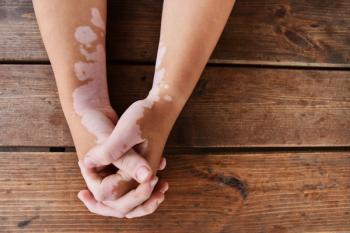
- Consultant for Pediatricians Vol 9 No 7
- Volume 9
- Issue 7
Facial Verrucae
An otherwise healthy 5-year-old girl presented with 2 papillary lesions just below the left lower outer lip. Five months earlier, she had had a common wart on the dorsal side of the web space between her left thumb and index finger. This wart was treated with electrocautery desiccation and curettage. The pictured lesions appeared after the wart on the left hand had been removed.
An otherwise healthy 5-year-old girl presented with 2 papillary lesions just below the left lower outer lip. Five months earlier, she had had a common wart on the dorsal side of the web space between her left thumb and index finger. This wart was treated with electrocautery desiccation and curettage. The pictured lesions appeared after the wart on the left hand had been removed.
Both facial lesions were excised at their base; the bases were then lightly electrocoagulated, and mupirocin ointment was applied 3 times a day until the skin had healed. The pathological diagnosis of the 2 lesions was verrucae. Cosmetic results were excellent. After about 1 year, the warts have not recurred.
The facial warts had most likely spread from the patient's hand through her habit of sucking the left thumb. (For a discussion of other adverse consequences of protracted finger-sucking-and a review of approaches to helping children break the finger-sucking habit-see "
Common skin warts are caused by human papillomavirus (HPV) types different from the HPV types that cause genital warts, cervical cancer, and other types of cancer. The 2 lesions removed from this young girl's face were both filiform warts. Filiform warts are the type most commonly seen around the mouth, chin, eyes, and nostrils.1 Warts can be transmitted by skin-to-skin contact, as in the case of this girl. They can also be spread by contact with a surface-such as the floor of a locker room or bathhouse- that has been exposed to warty skin.
The course of common warts is highly variable. Most, but not all, disappear on their own in months to years. However, patients usually find facial warts embarrassing and prefer not to wait for them to go away on their own. Removal methods that are used for facial warts include-in addition to electrocoagulation such as was used in this girl-cryotherapy, laser therapy, imiquimod, and topical retinoids. No one method is uniformly effective.
References:
REFERENCE:
1.
Habif TP.
Clinical Dermatology: A Color Guide to Diagnosis and Therapy
. 4th ed. Philadelphia: Mosby; 2004:368-378.
Articles in this issue
over 15 years ago
Asymptomatic Papular Rash in Infant With Rhinorrheaover 15 years ago
Breaking the Finger-Sucking Habitover 15 years ago
Vesicoureteral Refluxover 15 years ago
Internal Jugular Phlebectasiaover 15 years ago
Boy With Thick Plaques on His Palms and SolesNewsletter
Access practical, evidence-based guidance to support better care for our youngest patients. Join our email list for the latest clinical updates.










